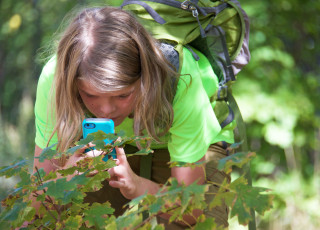The Natural History Museum of Utah and its Partners Encourage the Public to Join Citizen and Community Scientists Across the Globe in the City Nature Challenge April 24-27, 2020
April 16, 2020 – As citizen science (also known as community science) initiatives increase in popularity, this year’s fifth annual City Nature Challengeis set to take place in cities throughout the world. The global event calls on current and aspiring citizen scientists, nature and science fans, and people of all ages and backgrounds to observe and submit pictures of wild plants, animals, and fungi using the free mobile app iNaturalist. From Friday, April 24 to Monday, April 27, participants can upload their observations to the app, with identifications happening from Tuesday, April 28 to Sunday, May 3. Final results will be announced on Monday, May 4.
City Nature Challenge 2020: The Wasatch partners include: Hutchings Museum, Jordan River Commission, Natural History Museum of Utah, Ogden Nature Center, Red Butte Garden, SLC Parks & Public Lands, Salt Lake City Library, Salt Lake County Library, Stokes Nature Center, Swaner Preserve and EcoCenter, Thanksgiving Point, The Nature Conservancy, Tracy Aviary, US Department of Agriculture, US Fish & Wildlife Service, Utah’s Hogle Zoo, and Utah Open Lands.
This year’s City Nature Challenge will no longer be a competition, due to public health concerns related to COVID-19. Instead, participants are encouraged to embrace the collaborative aspect of sharing observations online with a digital community, and celebrate the healing power of nature safely, with social distancing, as they document their local biodiversity to the best of their ability within new public safety parameters. It is imperative that participants closely follow federal and local public health guidelines as they are updated in real-time in response to COVID-19.
During such uncertain times, it’s more important than ever to foster a sense of community, and the City Nature Challenge allows participants to do just that, in a manner that is safe and fun. For both budding and veteran citizen scientists, participating is easy.
1. Find wildlife! It can be any wild plant, animal, fungi, slime, mold, or any other evidence of life (scat, fur, tracks, shells, carcasses!) found in your neighborhood, home, backyard, or even through your windows. Look closely!
2. Take pictures of what you find using iNaturalist.
3. Learn more as your observations are identified, and contribute to scientific research from your own backyard.
“The City Nature Challenge offers a unique opportunity to reconnect to the environment where we live, and to contribute to scientific research in a safe and meaningful way,” said NHMU citizen science coordinator Ellen Eiriksson. “Although the large-scale events and opportunities for friendly team competition have been suspended, the essence of the event remains: to get outside and look around—wherever you are.”
As global human populations become increasingly concentrated in cities, it’s more important than ever to document urban biodiversity and help ensure the future of plants and wildlife. Large pools of data built through iNaturalist, natural history museums, and science organizations help authorities make informed conservation decisions that allow humans to sustainably coexist with the plants and animals in their neighborhoods. Scientists can’t be everywhere at once, so without community observations, they’d miss some incredible finds.
Erik Rickart, curator of vertebrate zoology at the Natural History Museum of Utah, leads a research project involving fox squirrels. “These colorful tree squirrels are native to the eastern U.S., and were first reported in Utah about 10 years ago,” Rickart explains. “They are now common and widespread in much of the Greater Salt Lake area. By identifying fox squirrels in your neighborhood during the City Nature Challenge, you can help us understand how they are adapting to our urban ecosystem.”
Last year, the City Nature Challenge tallied more than 950,000 observations made by over 35,000 people in over 150 participating cities. The Wasatch contributed 3,735 observations. This year, Utah partners comprising The Wasatch team intend to beat that number.
Christy Bills, entomology collections manager at the Natural History Museum of Utah, offers some tips for a successful backyard bio-blitz. “Invertebrates are all around us, all the time. The best way to notice them is to find an outdoor place to be still, and just wait to see what comes. iNaturalist accepts multiple pictures of a single observation, so take many pictures of your bug friends. A small clear container of any kind can be a help for this. The more angles the better!
“And don’t forget that each observation counts,” she adds. “Researchers are interested in what is in the environment and when it’s active, so your observations of even the most common things matter.”
At this challenging time with limited social engagements, the City Nature Challenge offers a connection more valuable now than ever: that of each person to the nature all around them.
iNaturalist: Signing up is easy and free. Visit inaturalist.org from your browser, or download iNaturalist from the Apple App Store or Google Play store.
More Information and Education Toolkit, visit citynaturechallenge.org.
Social Media Handles Hashtags
Facebook: @naturalhistorymuseumofutah #CityNatureChallenge
Instagram: @nhmu #CNCthewasatch
Twitter: @nhmu #backyardblitz
# # #
About the Natural History Museum of Utah
The Natural History Museum of Utah is one of the leading scientific research and cultural institutions in the country. Established in 1963, the Museum’s collections contain over 1.6 million objects and offers innovative exhibitions and educational programs to thousands of residents and visitors each year, including traveling and permanent exhibits, special events and other programs. With an expected attendance of 300,000 visitors a year, the Museum also offers a variety of outreach programs to communities and schools throughout Utah, reaching every school district in the state annually. The Museum has an active science program with more than 30 scientists and 10 field exhibitions each year.
Press contacts and links
-
Press Contact
Beth Mitchell

